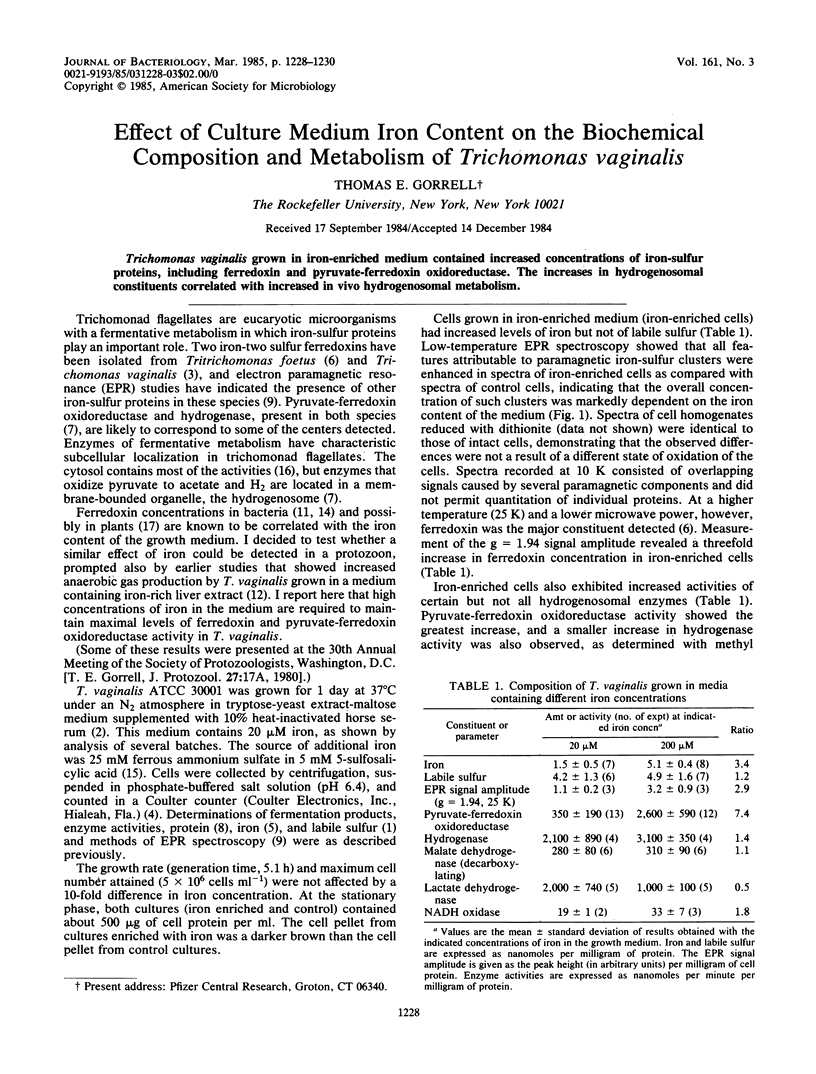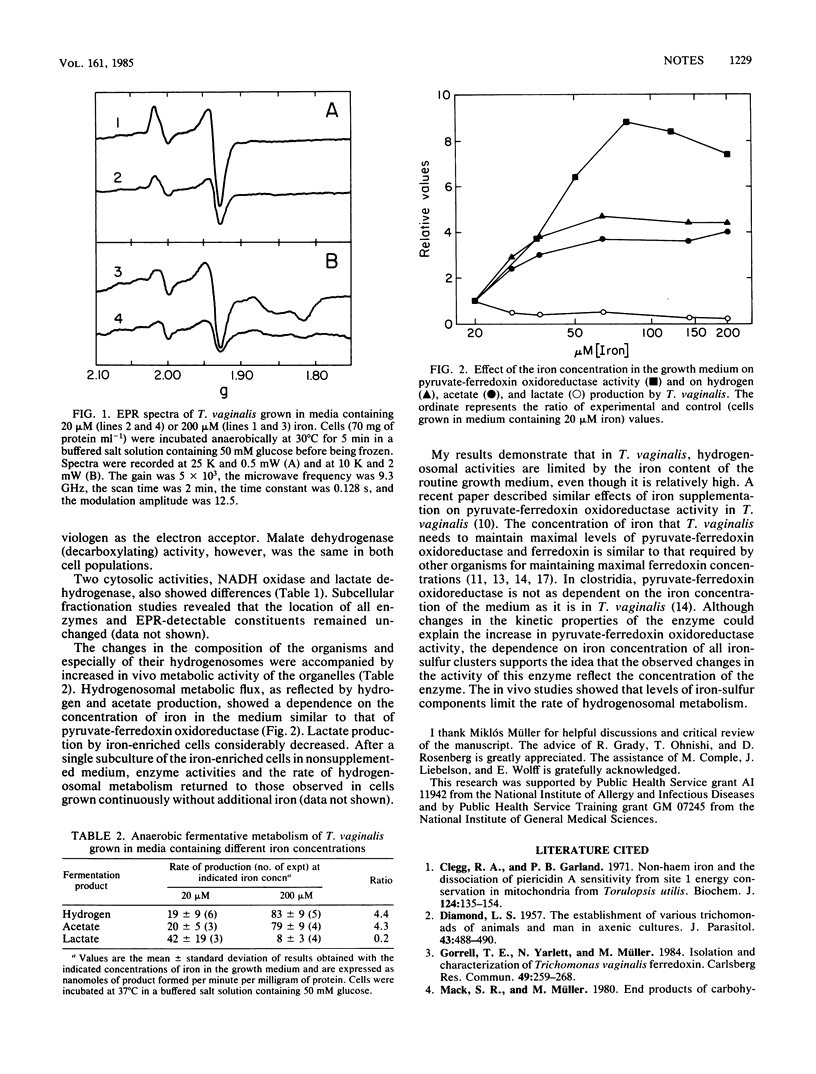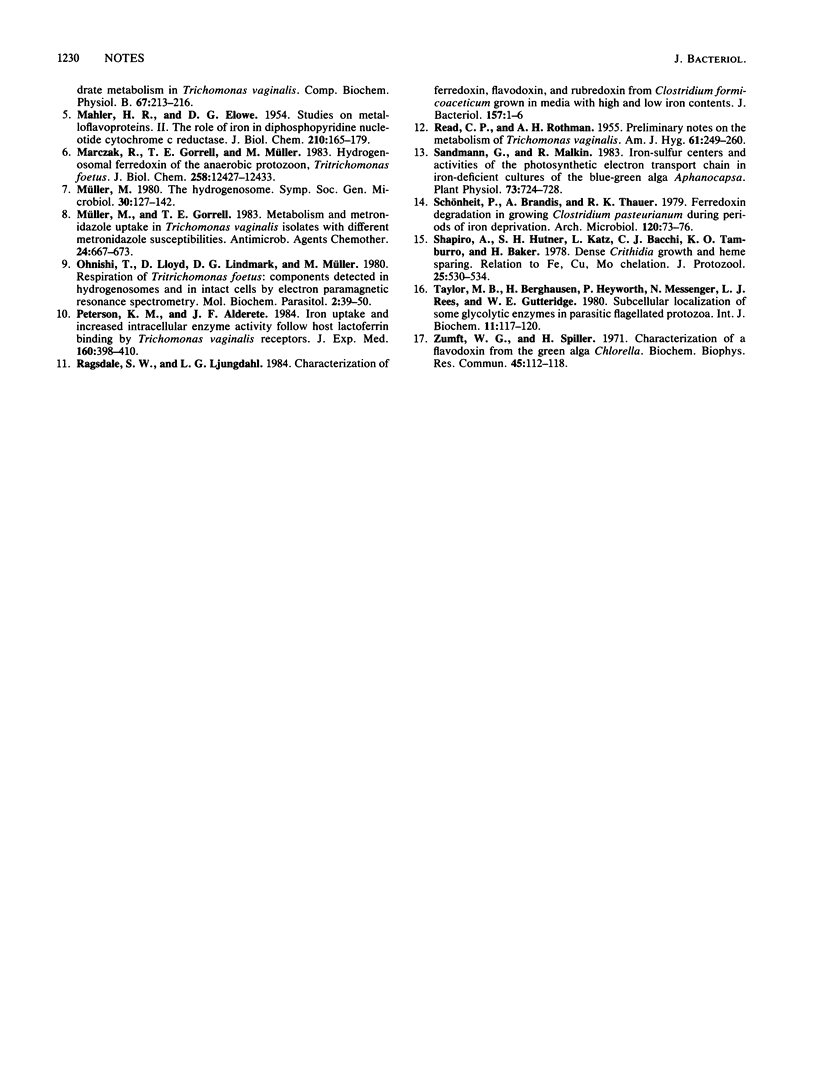Abstract
Trichomonas vaginalis grown in iron-enriched medium contained increased concentrations of iron-sulfur proteins, including ferredoxin and pyruvate-ferredoxin oxidoreductase. The increases in hydrogenosomal constituents correlated with increased in vivo hydrogenosomal metabolism.
Full text
PDF


Selected References
These references are in PubMed. This may not be the complete list of references from this article.
- Clegg R. A., Garland P. B. Non-haem iron and the dissociation of piericidin A sensitivity from site 1 energy conservation in mitochondria from Torulopsis utilis. Biochem J. 1971 Aug;124(1):135–151. doi: 10.1042/bj1240135. [DOI] [PMC free article] [PubMed] [Google Scholar]
- DIAMOND L. S. The establishment of various trichomonads of animals and man in axenic cultures. J Parasitol. 1957 Aug;43(4):488–490. [PubMed] [Google Scholar]
- MAHLER H. R., ELOWE D. G. Studies on metalloflavoproteins. II. The rôle of iron in diphosphopyridine nucleotide cytochrome c reductase. J Biol Chem. 1954 Sep;210(1):165–179. [PubMed] [Google Scholar]
- Marczak R., Gorrell T. E., Müller M. Hydrogenosomal ferredoxin of the anaerobic protozoon, Tritrichomonas foetus. J Biol Chem. 1983 Oct 25;258(20):12427–12433. [PubMed] [Google Scholar]
- Müller M., Gorrell T. E. Metabolism and metronidazole uptake in Trichomonas vaginalis isolates with different metronidazole susceptibilities. Antimicrob Agents Chemother. 1983 Nov;24(5):667–673. doi: 10.1128/aac.24.5.667. [DOI] [PMC free article] [PubMed] [Google Scholar]
- Ohnishi T., Lloyd D., Lindmark D. G., Müller M. Respiration of Tritrichomonas foetus: components detected in hydrogenosomes and in intact cells by electron paramagnetic resonance spectrometry. Mol Biochem Parasitol. 1980 Oct;2(1):39–50. doi: 10.1016/0166-6851(80)90047-x. [DOI] [PubMed] [Google Scholar]
- Peterson K. M., Alderete J. F. Iron uptake and increased intracellular enzyme activity follow host lactoferrin binding by Trichomonas vaginalis receptors. J Exp Med. 1984 Aug 1;160(2):398–410. doi: 10.1084/jem.160.2.398. [DOI] [PMC free article] [PubMed] [Google Scholar]
- Ragsdale S. W., Ljungdahl L. G. Characterization of ferredoxin, flavodoxin, and rubredoxin from Clostridium formicoaceticum grown in media with high and low iron contents. J Bacteriol. 1984 Jan;157(1):1–6. doi: 10.1128/jb.157.1.1-6.1984. [DOI] [PMC free article] [PubMed] [Google Scholar]
- Sandmann G., Malkin R. Iron-sulfur centers and activities of the photosynthetic electron transport chain in iron-deficient cultures of the blue-green alga aphanocapsa. Plant Physiol. 1983 Nov;73(3):724–728. doi: 10.1104/pp.73.3.724. [DOI] [PMC free article] [PubMed] [Google Scholar]
- Schönheit P., Brandis A., Thauer R. K. Ferredoxin degradation in growing Clostridium pasteurianum during periods of iron deprivation. Arch Microbiol. 1979 Jan 16;120(1):73–76. doi: 10.1007/BF00413277. [DOI] [PubMed] [Google Scholar]
- Shapiro A., Hutner S. H., Katz L., Bacchi C. J., Tamburro K. O., Baker H. Dense Crithidia growth and heme sparing: relation to Fe, Cu, Mo chelation. J Protozool. 1978 Nov;25(4):530–534. doi: 10.1111/j.1550-7408.1978.tb04180.x. [DOI] [PubMed] [Google Scholar]
- Taylor M. B., Berghausen H., Heyworth P., Messenger N., Rees L. J., Gutteridge W. E. Subcellular localization of some glycolytic enzymes in parasitic flagellated protozoa. Int J Biochem. 1980;11(2):117–120. doi: 10.1016/0020-711x(80)90243-8. [DOI] [PubMed] [Google Scholar]
- Zumft W. G., Spiller H. Characterization of a flavodoxin from the green alga Chlorella. Biochem Biophys Res Commun. 1971 Oct 1;45(1):112–118. doi: 10.1016/0006-291x(71)90057-x. [DOI] [PubMed] [Google Scholar]


